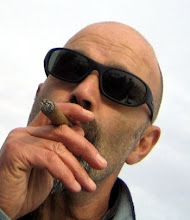Sipping breakfast coffee with David on a lovely cafe terrasse we are approached by yet another hawker, in a wheelchair. He is selling books. This happens all the time. The man has no hands. A bond develops between him and David, who is missing a hand from birth. They touch stumps in greeting, in acknowledgement. A mine, the man says.
Phnomh Penh is full of amputees, new ones everyday. Unexploded mines all over the country are a legacy of an atrocious civil war in the first half of the 70,s and then of the Pol Pot years. The day after tomorrow the country celebrates the 30th anniversary of the demise of that crazy regime. No one, bar a minor functionary or two, has been brought to justice. Pol Pot died an old man, cremated in a forest on a pyre of used tyres and old mattresses - I saw it in a film just now.
We went to the Killing Field a few miles out of town, just one of almost 2000 places of execution excavated so far, all over the country. Thousands were killed here. Unlike the Nazis, the Pol Pot regime never perfected the art of disposing of bodies. Bones and skulls have been dug up in shallow pits. 8000 skulls found here have been put in a glass sided tower inside a tall stupa that dominates the site. Many more than that died here, as logbooks show. Large tracts of the site have not yet been excavated, and may never be. Funds are low.
Most of the people killed here, many of them women and children, were brought in trucks from the Tuol Sleng prison in Phnomh Penh. This was in a former secondary school building in a suburb. Classrooms became cells and torture chambers. There are gruesome displays, reminding me of Auschwitz, Teresin........images of violence I can,t get my head around. This place too lacks funding. The government has stopped its grant. Evidence, documentation, artefacts, moulder with neglect.
On my way out a man with a horribly burnt face asks me for money. I hurry on. I can,t look him in the eye. Perhaps he was here in its hideous heyday.
I flee in confusion, and walk for hours to take refuge at last in the beautiful Museum of Antiquities. I stay for ages in a room full of the most wonderful standing Buddhas, wooden, ancient and fragile. I sit in the lovely gardens till almost closing time. I watch a rat or two scurry between manicured hedges, waiting impatiently for us tourists to leave so they can reclaim their domain for nocturnal delights.
My camera goes through weird death throes. Do I imagine the wisp of smoke that puffs out with the flash? The autofocus fails. Everything more than a centimeter beyond my lens is a blurred haze, a pretty, impressionistic fog. Is this how I am to snap Angkor Wat, where we go tomorrow, the most stupendous sight ever I am assured? Necessity being the mother of invention, I reconcile myself to creeping about the ruins, nose to the grindstone as it were, doing microscopic closeups of Buddha follicles. This morning the camera breathed its last, with its dead eye stuck open, unseeing, unretractable. RIP.
I go to the market, a fantastic French building and buy a new camera. Is this a true Lumix, and can the lens be Leica as it says?
Its been lovely here, and sobering.
Monday, 5 January 2009
Subscribe to:
Comments (Atom)
